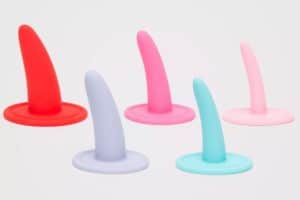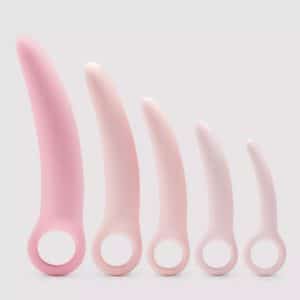Advertising disclosure: This content contains affiliate links and sponsored product placements. That means that if you make a purchase through one of these links, we receive a commission. See our Advertising Disclosure page for more info.
I receive two questions often about sex and menopause. One is about painful intercourse (dyspareunia) developing gradually after the onset of menopause. The other is about how to resume penetrative sexual activity after a long pause—even years.
Both of these issues have a common source—a vagina that has become drier and drier and vaginal walls that have become thinner and thinner after menopause. This is called vaginal atrophy. These changes are common to all women, although the rate of onset and the severity of the symptoms vary. The culprit is loss of ovarian estrogen production with menopause. That’s why some kind of estrogen replacement therapy is important.
The vagina is truly an organ to which the phrase “use it or lose it” applies. Maintaining regular penetrative sexual activity is important, but if that’s not possible, vaginal dilators offer a reasonable alternative.
What are vaginal dilators?
Dilators are relatively unknown. However, they can play a crucial role in helping women maintain their vaginas for comfortable sexual function and in preparing the vagina for resumption of penetrative sex after a long pause.
Vaginal dilators have been around a long time! Hippocrates (c. 460-370 BC) was a Greek physician considered the father of modern medicine. A collection of around 60 of his works exists, one of which is On the Diseases of Women I-II.
In this work, dilators are referred to “as consisting of six, flat pieces of wood each being a little longer than the last…These, after being smeared with oil, were to be introduced with the object of dilating the vagina.”¹
The Romans also knew about the usefulness of dilators. The earliest dilators found were of bronze and were among surgical instruments at Pompeii, an Italian city destroyed by a volcanic eruption in 79 AD.
Modern vaginal dilators are cylindrical tools of graduated widths and lengths made of plastic or silicone. They usually come in kits that range in size from the small finger to an erect penis.
Dilators for Dyspareunia and Vaginal Atrophy
As we covered a bit ago, after menopause the vagina gradually becomes drier and less pliable. To minimize these changes, maintain regular penetrative activity and, with your doctor’s prescription, use topical vaginal estrogen (more about that later).
Why do I say “penetrative activity” and not just “intercourse?” Intercourse often brings to mind only PIV (penis-in-vagina) sex. Other types of sexual penetration many women enjoy—from fingers or strap-on dildos, for example—can also become difficult after menopause. Perhaps you’ve lost your partner or are not in a relationship at this time. Or perhaps PIV intercourse isn’t possible because of a partner’s difficulty in getting or maintaining an erection (ED).
In these circumstances, dilators are a great option for keeping the vagina comfortable and ready for sexual activity.
Are there other uses for vaginal dilators that don’t involve sex?
There are! The use of vaginal dilators can help keep pelvic exams comfortable for the patient and informative for the doctor. Dilators can also be used to treat vaginal dryness and shortening from surgery, pelvic radiation, and chemotherapy.
How to Use Vaginal Dilators
Choose a private and comfortable place to lie down, like the bedroom.
- Lie down on your back with your knees bent. Spread your legs about shoulder width apart.
- Make sure you can easily touch the vaginal opening. A hand-held mirror can be a helpful guide.
- RELAX
- Lubricate (Astroglide, Replens) the smallest dilator and your vaginal opening with your finger. If your dilators are made of silicone, make sure to use a water-based lubricant.
- Slowly and with gentle pressure, insert the dilator as far as comfortably possible in the direction of your spine. Some mild discomfort may occur at first. However, if there is significant pain, stop and make an appointment with your doctor before trying again.
- Keep the dilator in place for 10-15 minutes. You can gently push it in and out and circularly rotate it at the vaginal opening.
- Once you can comfortably insert the dilator all of the way into the vagina, you are ready to move to the next larger size.
- As with intercourse, it is important to urinate after using a dilator to prevent urinary tract infections.
You may have a small amount of bleeding when getting started. If it is enough to soak a pad or lasts longer than 24 hours, don’t repeat until you see your doctor.
How long does it take for vaginal dilators to “work?” How often should they be used?
A normal schedule is 3-4 times weekly for 15 minutes. I recommend beginning dilator use within two years of the onset of menopause. If it has been more than two years since penetrative sexual activity, it may take 3-6 months to regain vaginal integrity and pliability sufficient for vaginal intercourse. Vaginal dilation can be done as long as you want, even lifelong.
Where to Buy Vaginal Dilators
This can be a little tricky. Vaginal dilators are not often found in drugstores (they should be!) Sex shops sometimes carry them, but not everyone has access to a good reputable store staffed by knowledgeable sex educators (yes, these exist!) Or, you may not feel comfortable shopping in person at a sex shop.
That means buying dilators online is often your best bet. There are sexual health stores online that offer them, including some of our affiliate merchants. I’ve included links to some of their dilator products in this article.
If you’re talking with your doctor about using vaginal dilators, you can ask about his or her preferred brand. You can ask if he or she knows a local place to buy them, or you can search the brand name online.
A Brief Message About Estrogen Replacement Therapy
Estrogen is good for many menopausal/postmenopausal conditions: hot flashes and night sweats, vaginal dryness and painful intercourse, bladder function, skin quality, and heart disease to name a few. Above all, it is critical to prevent osteoporosis, which can be disabling. If you’re discussing vaginal dryness with your doctor, don’t forget to ask about estrogen therapy.
What is the take-home message?
- Vaginal dilators are not on the radar of many women nor many physicians, but they should be. They’re valuable for maintaining or regaining vaginal integrity.
- A decrease in ovarian estrogen production with menopause can result in painful intercourse or difficulty in resuming intercourse after a long pause.
- To minimize these changes, maintain regular penetrative activity and talk with your doctor about topical vaginal estrogen. Dilators are a reasonable alternative to PIV intercourse or other penetrative sexual activity (fingers, vibrators, and dildos).
- Dilators are a great option for keeping the vagina ready and comfortable for sexual activity and/or pelvic exams.
- Vaginal dilation can be done as long as you want, even lifelong.
- Don’t forget estrogen when talking with your doctor about a vaginal dilator.
If you have more questions about vaginal dilators or other sexual health issues, don’t hesitate to Ask the Expert.
As per our Terms of Use, this article is for general educational and informational purposes only and is not meant to serve as a substitute for professional medical advice. Consult with your own physician or health care practitioner regarding the use of any information received here before using or relying on it. Your physician or health care practitioner should address any and all medical questions, concerns, and decisions regarding the possible treatment of any medical condition.
1 Thom[son, CJS, PhD, The evolution and development of surgical instruments, British Journal of Surgery 1937.







